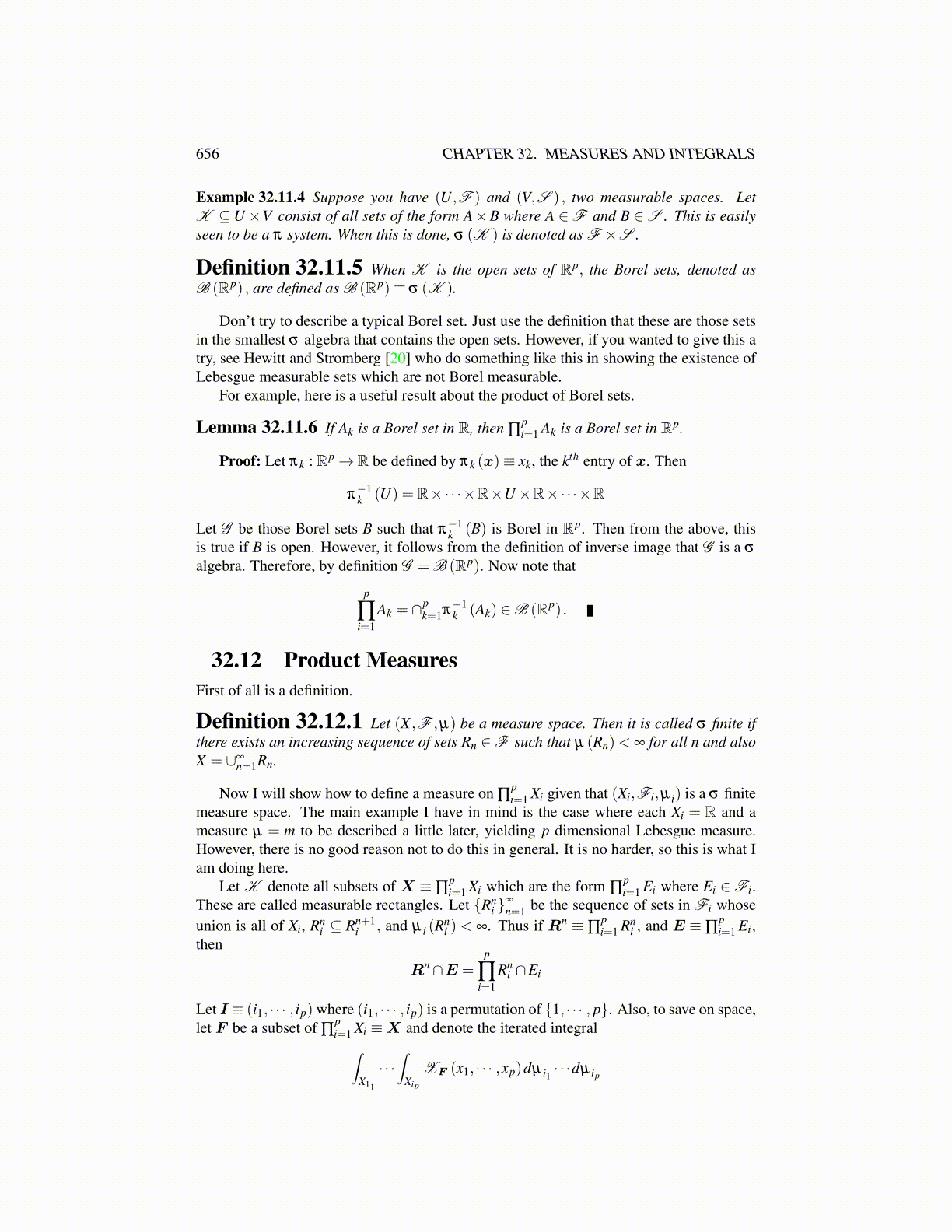
656 CHAPTER 32. MEASURES AND INTEGRALS
9. You have a measure space (Ω,F ,P) where P is a probability measure on F . Thenyou also have a measurable function X : Ω →Rp, meaning that X−1 (U) ∈ F when-ever U is open. Now define a measure on B (Rp) denoted by λ X and defined byλ X (E) = P({ω : X (ω) ∈ E}) . Explain why this yields a well defined probabilitymeasure on B (Rn). This is called the distribution measure.
10. Let K ⊆V where K is closed and V is open. Consider the following function.
f (x) =dist(x,VC
)dist(x,K)+dist(x,VC)
Explain why this function is continuous, equals 0 off V and equals 1 on K. Theneeded function is in Proposition 15.6.4.
11. Let (Ω,F ) be a measurable space and let f : Ω → Rp be a measurable functionmeaning that f−1 (U) ∈ F whenever U is open. Then σ ( f ) denotes the smallest σ
algebra such that f is measurable with respect to this σ algebra. Show that σ ( f ) ={f−1 (E) : E ∈ B (Rp)
}.
12. There is a monumentally important theorem called the Borel Cantelli lemma. It saysthe following. If you have a measure space (Ω,F ,µ) and if {Ei} ⊆ F is suchthat ∑
∞i=1 µ (Ei) < ∞, then there exists a set N of measure 0 (µ (N) = 0) such that if
ω /∈ N, then ω is in only finitely many of the Ei. Hint: You might look at the set ofall ω which are in infinitely many of the Ei. First explain why this set is of the form∩∞
n=1 ∪k≥n Ek.
13. Let (Ω,F ,µ) be a measure space. A sequence of functions { fn} is said to convergein measure to a measurable function f if and only if for each ε > 0,
limn→∞
µ ({ω : | fn (ω)− f (ω)|> ε}) = 0
Show that if this happens, then there exists a subsequence{
fnk
}and a set of measure
N such that if ω /∈ N, then
limnk→∞
fnk (ω) = f (ω) .
Also show that if µ is finite and limn→∞ fn (ω)= f (ω) , then fn converges in measureto f .
14. Let {rn}∞
n=1 be an enumeration of the rational numbers in [0,1] meaning that everyrational number is included in {rn}∞
n=1 for some n and let fn (x) = 0 except for whenx ∈ {r1, · · · ,rn} when it is 1. Explain why fn is Riemann integrable and has Riemannintegral 0. However, limn→∞ fn (x) ≡ f (x) is 1 on rationals and 0 elsewhere so thisisn’t even Riemann integrable. It will be shown later that the two integrals givethe same answer whenever the function is Riemann integrable. Thus the Lebesgueintegral of fn will be 0. So what is the Lebesgue integral of the function which is 1on the rationals and 0 on the irrationals? Explain why this is so.
15. Prove Chebyshev’s inequality mp ({x : | f (x)|> λ})≤ 1λ∥ f∥L1 ≡ 1
λ
∫| f |dmp.